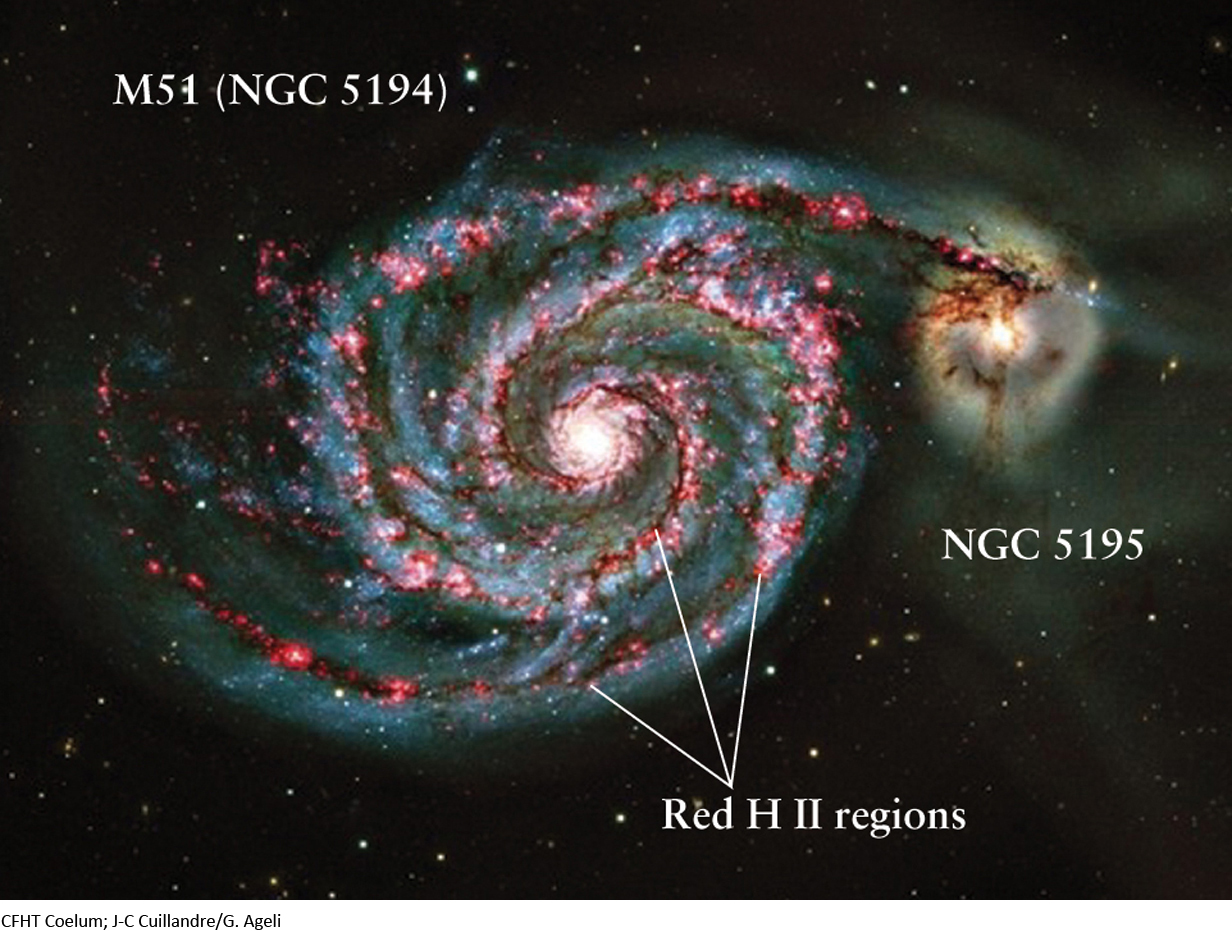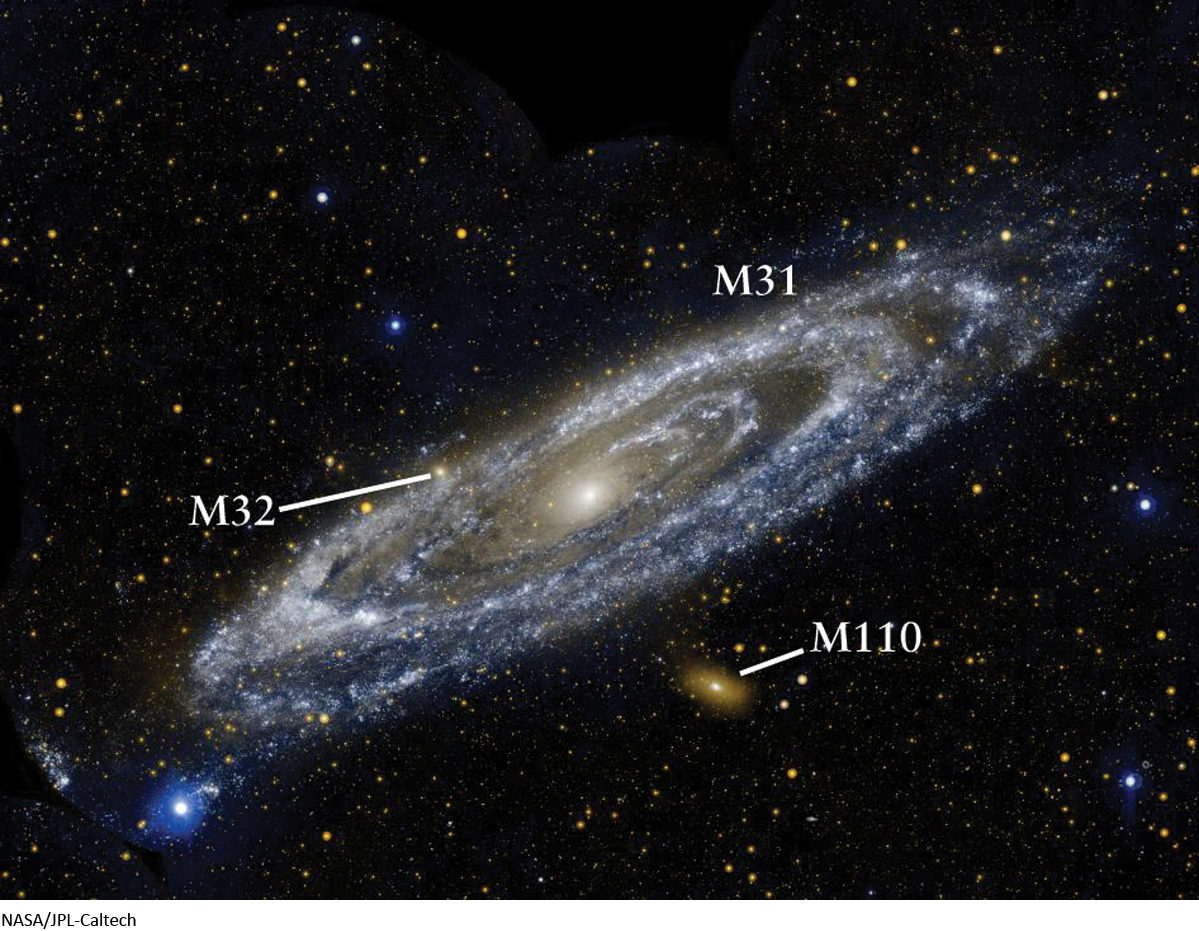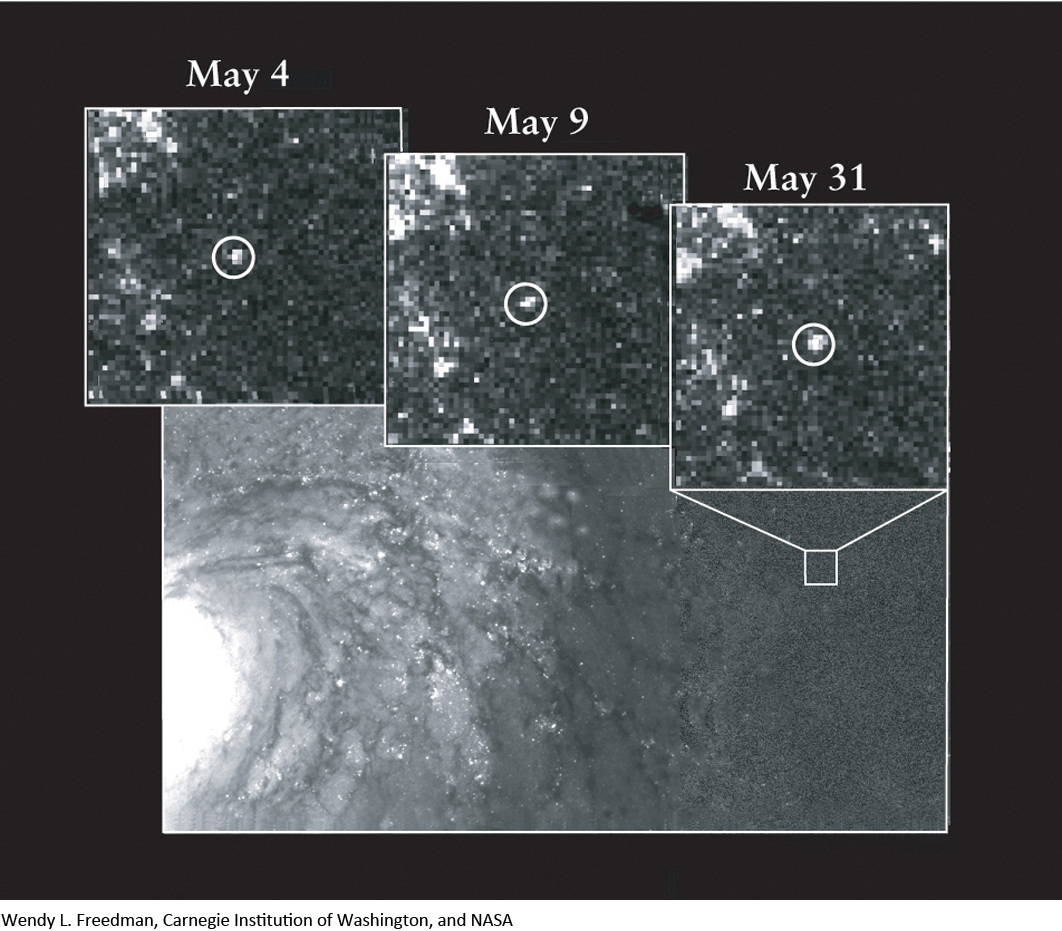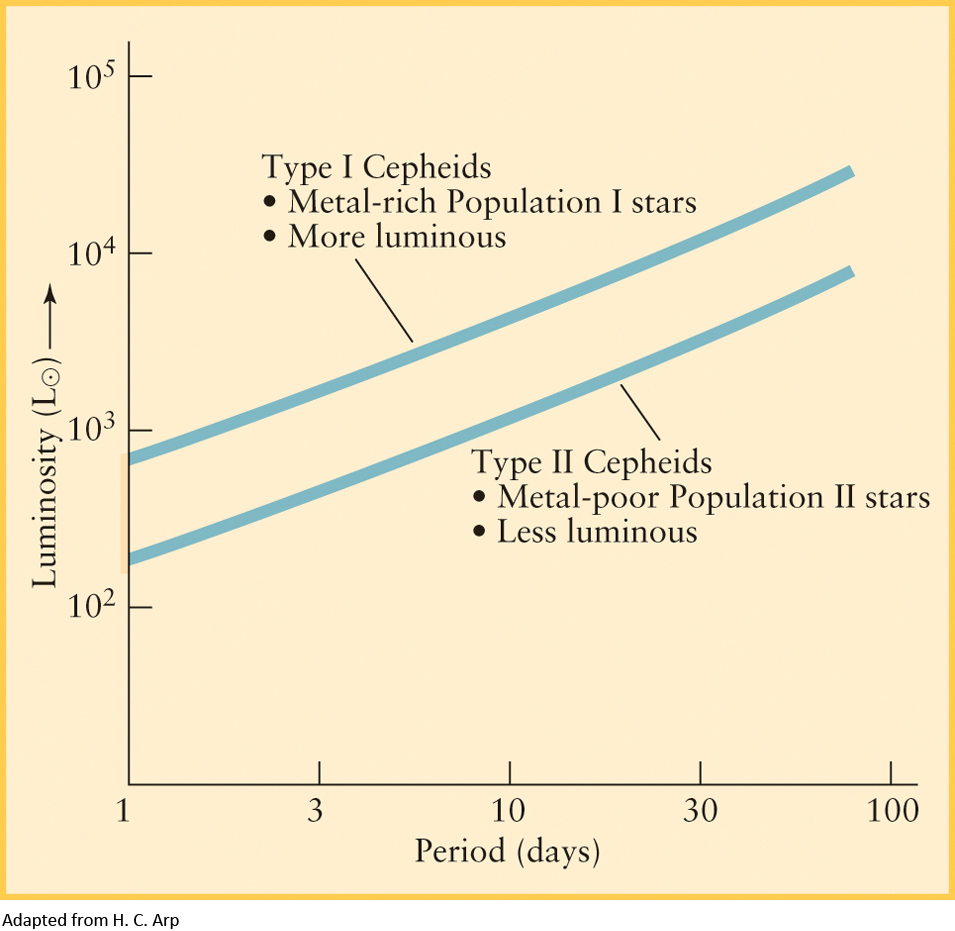14-1 When galaxies were first discovered, it was not clear that they lie far beyond the Milky Way until their variable stars were carefully observed
We haven’t always known that the universe is filled with countless stars clumped together into galaxies. In fact, as recently as 100 years ago, astronomers were not convinced that any galaxies existed beyond our own. What we were sure of was that there were some objects observed in the night sky besides stars, comets, and planets. Using telescopes, astronomers had cataloged more than a hundred “fuzzy”-looking objects. Originally, all cloudlike-looking objects were described as nebulae. (The word nebula is much like the adjective nebulous, which means hazy, unclear, or ill-defined.) The object shown in Figure 14-1 was once known as the “spiral nebula,” and the one in Figure 14-2 is the Great Nebula in Andromeda, and most people assumed that both were relatively nearby objects within the realm of our neighborhood of stars. Comet-hunting astronomers kept catalogs of these diffuse, wispy-looking objects because in small telescopes they often looked like comets. (The objects numbered and cataloged by French astronomer Charles Messier between 1758 and 1782 are often known by their Messier number, or M-number—Figure 14-1 is also known as M51 and Figure 14-2 is also known as M31.)


A considerable number of nebulae are in fact nearby regions of dust and gas, scattered throughout the Milky Way. (Figures 11-3 and 11-23 show some examples.) It therefore seemed reasonable that “spiral nebulae,” even though they are very different in shape from other sorts of nebulae, could also be nearby neighbors. But, other astronomers wondered if these were instead giant objects far beyond our own realm of stars.
Up until about 100 years ago, the astronomical community was increasingly divided over the nature of the spiral nebulae. In April 1920, two opposing ideas were presented before the National Academy of Sciences in Washington, D.C. On one side was Harlow Shapley from the Mount Wilson Observatory. Shapley thought the spiral nebulae were relatively small, nearby objects scattered around our Galaxy like globular clusters. Opposing Shapley was Heber D. Curtis of the University of California’s Lick Observatory. Curtis argued that some of these spiral nebulae were an isolated and rotating system of stars much like our own Galaxy.
329
The Shapley-Curtis “debate” generated much heat but little came to light or was resolved. Nothing was decided because no one could present conclusive evidence to demonstrate exactly the distance to the spiral nebulae. Astronomy desperately needed a definitive determination of the distance to a spiral nebula, which could not be done unless someone could identify an individual star with the nebula. Such a measurement became the first great achievement of a young man who studied astronomy at the Yerkes Observatory, near Chicago. His name was Edwin Hubble.
Question
ConceptCheck 14-1: If you were observing one of the “spiral nebulae” and determined that it was closer than some of the stars of our Galaxy, would you be providing evidence in support of Shapley’s argument or Curtis’s argument?
Hubble Proved that the Spiral Nebulae Are Far Beyond the Milky Way
After completing his studies, Edwin Hubble joined the staff of the Mount Wilson Observatory in Pasadena, California. On October 6, 1923, he took a historic photograph of the Andromeda “Nebula,” one of the spiral nebulae around which controversy raged. Figure 14-2 is a modern photograph of this object.
Hubble carefully examined the photo he had taken and discovered what he at first thought to be an exploding nova. Referring to previous photographs of that region, he soon realized that the object was actually a Cepheid variable star. Further scrutiny of additional plates over the next several months revealed several more Cepheids. Figure 14-3 shows modern observations of a Cepheid in another “spiral nebula.”

This discovery was a critical finding because Cepheid variables allow astronomers to determine distances. An astronomer begins by carefully measuring the variations in apparent brightness of a Cepheid variable, then recording the results in the form of a plot of brightness versus time, or light curve (see Figure 13-4a). This graph gives the variable star’s period and average brightness. Given the star’s period, the astronomer then uses the period-luminosity relation shown in Figure 14-4 to find the Cepheid’s average luminosity. (To be more precise, an astronomer must also examine the spectrum of the star to determine whether it is a metal-rich Type I Cepheid or a metal-poor Type II Cepheid. As Figure 14-4 shows, these have somewhat different period-luminosity relations.) Knowing both the apparent brightness and luminosity of the Cepheid, the astronomer can then use the inverse-square law to calculate the distance to the star. Box 14-1 Tools of the Astronomer’s Trade: Cepheids and Supernovae as Indicators of Distance provides examples of how this is done. Cepheid variables are intrinsically quite luminous, with average luminosities that can exceed 104 L⊙. Hubble realized that for these luminous stars to appear as dim as they were on his photographs of the Andromeda “Nebula,” they must be extremely far away. Straightforward calculations using modern data reveal that M31 is some 2.5 million ly from Earth. Based on its angular size, M31 has a diameter larger than the diameter of our own Milky Way Galaxy!

These results prove that the Andromeda “Nebula” is actually an enormous stellar system, far beyond the confines of the Milky Way with a vast empty space between. Today, this system is properly called the Andromeda Galaxy. (Under good observing conditions, you can actually see this galaxy’s central bulge with the naked eye. If you could see the entire Andromeda Galaxy, it would cover an area of the sky roughly 5 times as large as the full moon.)
330
TOOLS OF THE ASTRONOMER’S TRADE
Cepheids and Supernovae as Indicators of Distance
Because their periods are directly linked to their luminosities, Cepheid variables are one of the most reliable tools astronomers have for determining the distances to galaxies. To this day, astronomers use this link—much as Hubble did back in the 1920s—to measure intergalactic distances. More recently, they have begun to use Type Ia supernovae, which are far more luminous and thus can be seen much farther away, to determine the distances to very remote galaxies.
EXAMPLE: In 1992, a team of astronomers observed Cepheid variables in a galaxy called IC 4182 to deduce this galaxy’s distance from Earth. One such Cepheid has a period of 42.0 days and an average apparent magnitude (m) of +22.0. By comparison, the dimmest star you can see with the naked eye has m = +6; this Cepheid in IC 4182 appears less than one one-millionth as bright. The star’s spectrum shows that it is a metal-rich Type I Cepheid variable.
According to the period-luminosity relation shown in Figure 14-4, such a Type I Cepheid with a period of 42.0 days has an average luminosity of 33,000 L⊙. An equivalent statement is that this Cepheid has an average absolute magnitude (M) of −6.5. (This compares to M = +4.8 for the Sun.) Use this information to determine the distance to IC 4182.
Situation: We are given the apparent magnitude m = +22.0 and the absolute magnitude M = −6.5 of the Cepheid variable star in IC 4182. Our goal is to calculate the distance to this star, and hence the distance to the galaxy of which it is part.
Tools: We use the relationship between apparent magnitude, absolute magnitude, and distance written as a mathematical relationship m − M = 5 log d − 5.
Answer: Given that the apparent magnitude of a star is related to its absolute magnitude and distance in parsecs (d), where one parsec is 3.26 ly, using
m − M = 5 log d − 5
This can be rewritten as
d = 10(m − M + 5)/5 parsecs
We have m − M = (+22.0) − (−6.5) = 22.0 + 6.5 = 28.5. Hence, our equation rearranges to become
d = 10(28.5 + 5)/5 parsecs = 106.7 parsecs = 5 × 106 parsecs
(A calculator is needed to calculate the quantity 106.7.)
Review: Our result tells us that the galaxy is 5 million parcsecs, or 5 Mpc, from Earth (1 Mpc = 106 pc). This distance can also be expressed as 16 million ly.
EXAMPLE: Astronomers are interested in IC 4182 because a Type Ia supernova was observed there in 1937. All Type Ia supernovae are exploding white dwarfs that reach nearly the same maximum brightness at the peak of their outburst. Once astronomers know the peak absolute magnitude of Type Ia supernovae, they can use these supernovae as distance indicators. Because the distance to IC 4182 is known from its Cepheids, the 1937 observations of the supernova in that galaxy help us calibrate Type Ia supernovae as distance indicators.
At maximum brightness, the 1937 supernova reached an apparent magnitude of m = +8.6. What was its absolute magnitude at maximum brightness?
Situation: We are given the supernova’s apparent magnitude m, and we know its distance from the previous example. Our goal is to calculate its absolute magnitude M.
Tools: We again use the relationship m − M = 5 log d − 5.
Answer: We could plug in the value of d found in the previous example. But it is simpler to note that the distance modulus m − M has the same value no matter whether it refers to a Cepheid, a supernova, or any other object, just so it is at the same distance d. From the Cepheid example we have m − M = 28.5 for IC 4182, so
M = m − (m − M) = 8.6 − (28.5) = − 19.9
This absolute magnitude corresponds to a remarkable peak luminosity of 1010 L⊙.
Review: Whenever astronomers find a Type Ia supernova in a remote galaxy, they can combine this absolute magnitude with the observed maximum apparent magnitude to get the galaxy’s distance modulus, from which the galaxy’s distance can be easily calculated (just as we did above for the Cepheids in IC 4182). This technique has been used to determine the distances to galaxies hundreds of millions of parsecs away.
Galaxies are so far away that their distances from us are usually given in millions of light-years. For example, the distance to the galaxies in the image that opens this chapter is about 55 million ly.
Hubble’s results showing stars within Andromeda and allowing its distance to be calculated, which were presented at a meeting of the American Astronomical Society on December 30, 1924, settled the Shapley-Curtis “debate” once and for all. The universe was recognized to be far larger and populated with far bigger objects than anyone had seriously imagined. Hubble had discovered the realm of the galaxies.
Question
ConceptCheck 14-2: If a nearby galaxy were discovered, why would astronomers immediately look for Cepheids?
331